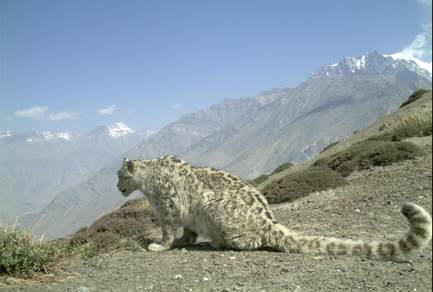SNOW LEOPARD

Disclaimer: Copyright infringement not intended.
Context: The first-ever recording of the snow leopard from the Baltal-Zojila region has renewed the hope for the elusive predator in the higher altitudes of Jammu and Kashmir and Ladakh.
Details:
- The Snow Leopard Population Assessment of India (SPAI) has been concluded so far in Himachal Pradesh and Uttarakhand. The estimated population of the great cat is 50 and 100 in these two States respectively.
- The Department of Wildlife Protection has been conducting surveys with partner NGOs to understand presence and abundance of snow leopards under the SPAI project funded by the Ministry of Environment Forests and Climate Change.
- Snow leopard surveys have often focused in neighbouring areas of Ladakh, Himachal Pradesh and Uttarakhand.
- The survey was expanded to the Baltal-Zojila region of Kashmir recently
- This finding brings renewed hope to Kashmir and its high-altitude regions, as the presence of the snow leopard can be used as a conservation flagship to address high-mountain development issues for people and the environment.
- Apart from the camera-trapping of the Asiatic ibex, brown bear, Kashmir musk deer and other rare species, the survey has yielded incredible information on the other biodiversity components of such habitats, interactions and threats
About:
- The elusive and charismatic snow leopard feeds on hoofed animals (ungulates) including the Siberian ibex, blue sheep, urial and argali in the Himalayas.
- The snow leopard detection probability was high if the site was used by its prey species, i.e., ibex and blue sheep.
- Whereas, in the case of the prey species, the probability of detection was low when the predator (snow leopard) was present and detected.
- Snow leopards use rugged mountainous areas or non-forested areas covering an altitude between 3200m-5200m.
- Habitat covariates, such as barren area, grassland, aspect, slope and distance to water were important drivers of habitat use for the snow leopard as well as its prey species.
- Classified as ‘Vulnerable’ by the International Union for Conservation of Nature (IUCN) Red list and listed in Schedule-I species of the Indian Wildlife (Protection) Act, 1972, snow leopards are elusive mountain cats whose survival depends on depends primarily on wild ungulates.
- Higher up in the mountains, predators such as snow leopards regulated the populations of herbivores such as the blue sheep and Siberian ibex, thereby safeguarding the health of grasslands and a long-term absence of snow leopards could cause trophic cascades as ungulate populations would likely increase, leading to depletion of vegetation cover.
- Snow leopards have a vast but fragmented distribution across the mountainous landscape of central Asia, which covers different parts of the Himalayas such as Ladakh, Himachal Pradesh, Uttarakhand, and Sikkim.
- This charismatic species is largely threatened because of the loss of natural prey species, retaliatory killing due to conflict with humans and illegal trade of its fur and bones.




1.png)
